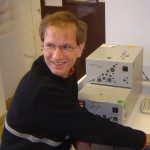Link to Pubmed [PMID] – 17785459
J. Biol. Chem. 2007 Nov;282(45):33118-31
Competitive antagonists of the human prolactin (hPRL) receptor are a novel class of molecules of potential therapeutic interest in the context of cancer. We recently developed the pure antagonist Del1-9-G129R-hPRL by deleting the nine N-terminal residues of G129R-hPRL, a first generation partial antagonist. We determined the crystallographic structure of Del1-9-G129R-hPRL, which revealed no major change compared with wild type hPRL, indicating that its pure antagonistic properties are intrinsically due to the mutations. To decipher the molecular bases of pure antagonism, we compared the biological, physicochemical, and structural properties of numerous hPRL variants harboring N-terminal or Gly(129) mutations, alone or combined. The pure versus partial antagonistic properties of the multiple hPRL variants could not be correlated to differences in their affinities toward the hPRL receptor, especially at site 2 as determined by surface plasmon resonance. On the contrary, residual agonism of the hPRL variants was found to be inversely correlated to their thermodynamic stability, which was altered by all the Gly(129) mutations but not by those involving the N terminus. We therefore propose that residual agonism can be abolished either by further disrupting hormone site 2-receptor contacts by N-terminal deletion, as in Del1-9-G129R-hPRL, or by stabilizing hPRL and constraining its intrinsic flexibility, as in G129V-hPRL.


